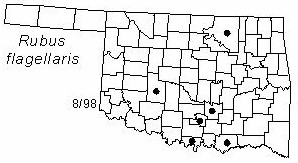Trailing vine which often roots at the nodes, may reach 60 cm (24 in) tall. Twigs green or red, primocanes terete, glabrous and glandless, spines about 3 mm (1/8 in) long, stout and hooked; pith green. Leaves alternate, palmately compound, 3-5 leaflets; leaflets ovate, elliptic to rhombic; floricane leaflets are often smaller than those on the primocanes; glabrous, but may be lightly pubescent beneath; broad to sub-cordate at base; narrow to acute at apex; margins serrate to doubly serrate; petiole and rachis armed, glabrous to thinly pilose. Inflorescence a corymb with few flowers (1-6) on long slender pedicels; flowers 2-3 cm (0.75-1.25 in) in diameter; calyx lobes 5, narrow, pubescent, reflexed; petals 5, white; pistils many, inserted on hypanthium; stamens numerous; flowers appear from May to June. Fruit an aggregation of drupelets, 10-15 mm (0.4-0.6 in) in diameter, globose to short-oblong, black; fruits mature June to August.
Distribution: Oklahoma and Texas, east to Georgia, north to New Brunswick, west to Minnesota and Missouri.
Habitat: open fields, woodlands and forest margins.
Comment: Rubus is a Roman name meaning red; flagellaris refers to the long, thin whip-like appearance of the primocanes.
Field identification: Rubus is a complex genus. Species are difficult to identify due to frequent hybridization and introgression.
Horticulture: several varieties of dewberry are available commercially.
Medinical uses: The Osage prepared a tea using northern dewberry roots to calm stomach irritation.
Food uses: the fruits are large and tasty. They can be eaten raw or used in jams, jellies, and sauces. The leaves were used to make tea and young shoots were peeled and eaten raw.
Wildlife benefits: dewberry fruits are eaten by many species of birds and mammals.
NWI status: UPL,FACU-.
Distribution in Oklahoma: 
BACK
NEXT
RETURN TO INDEX
Last update: 9/17/99
 Go to Oklahoma Biological Survey Home Page
Go to Oklahoma Biological Survey Home Page
 Disclaimer
Disclaimer